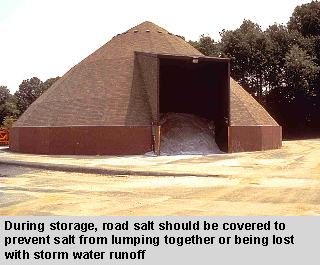
Description
The application and storage of deicing materials, most commonly salts such as sodium chloride, can lead to water quality problems for surrounding areas (Koppelman et al., 1984). Salts, gravel, sand, and other materials are applied to highways and roads to reduce the amount of ice during winter storm events. Salts lower the melting point of ice, allowing roadways to stay free of ice buildup during cold winters. Sand and gravel increase traction on the road, making travel safer.
Applicability
This practice occurs in areas that receive snowfall in winter months and require deicing materials. Municipalities in these areas must ensure proper storage and application for equipment and materials.
Siting and Design Considerations
Many of the problems associated with contamination of local waterways stem from the improper storage of deicing materials (Koppelman et al., 1984). Salts are very soluble when they come into contact with stormwater. They can migrate into ground water used for public water supplies and also contaminate surface waters.
More information about road deicing materials can be found at the American Association of State Highway and Transportation Officials  website. website.
Limitations
Road salt is the least expensive material for deicing operations; however, once the full social costs are taken into account, alternative products and better management and application of salts become increasingly attractive options.
Table 1. Deicing Alternatives (Keating, 2004)
|
Substance |
Cost |
Characteristics |
|
Calcium Chloride (CaCl2)
|
Flake $290/ton,
pellet $340/ton |
Melts ice at temperatures of -25 ° F
If used as recommended, will not harm vegetation
|
|
Magnesium Chloride (MgCl2) |
Flake $260/ton, pellet $300/ton |
Lowest practical temperature: 5 ° F
If used as recommended, will not harm vegetation; however, MgCl2, on a percentage basis, contains 17-56% more chloride ion than other salt-type deicers
|
|
Potassium Chloride (KCl) |
$240/ton |
Lowest practical temperature: 12 ° F
Will not harm vegetation
|
|
Urea |
$280/ton |
Lowest practical temperature: 15 ° F
Will not harm vegetation
|
|
Calcium Magnesium Acetate (CMA) |
$2,000/ton |
Will work below 0 ° F
Low toxicity and biodegradable
|
Maintenance Considerations
Covering stored road salts may be costly; however, the benefits are greater than the perceived costs. Properly storing road salts prevents the salt from lumping together, which makes it easier to load and apply. In addition, covering salt storage piles reduces salt loss from stormwater runoff and potential contamination to streams, aquifers, and estuarine areas. Salt storage piles should be located outside the 100-year floodplain for further protection against surface water contamination.
If used during road salt application, certain best management practices can produce significant environmental benefits. The amount of road salt applied should be regulated to prevent oversalting of roadways and increasing runoff concentrations. The amount of salt applied should be varied to reflect site-specific characteristics, such as road width and design, traffic concentration, and proximity to surface waters. Calibration devices mounted in the cabs of spreader-trucks help maintenance workers apply the proper amount of road salt. Alternative materials, such as sand or gravel, should be used in especially sensitive areas.
Cost Considerations
See Table 1 for the costs of different deicing alternative substances.
References
American Association of State Highway and Transportation Officials. 2000. AASHTO: Transportation Center of Excellence. [www.transportation.org  ]. Accessed September 15, 2005. ]. Accessed September 15, 2005.
Keating, Janis. 2004. Stormwater. Deicing Salt: Still on the Table [www.forester.net/sw_0106_deicing.html  ]. Accessed October 17, 2005. ]. Accessed October 17, 2005.
Koppelman, L.E., E. Tanenbaum, and C. Swick. 1984. Nonpoint Source Management Handbook. Long Island Regional Planning Board, Hauppauge, NY.
USEPA. 1995. Planning Considerations for Roads, Highways and Bridges. U.S. Environmental Protection Agency, Office of Water, Washington, DC. [www.epa.gov/OWOW/NPS/education/planroad.html].
| 
